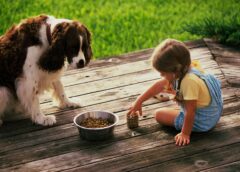What is the environmental paw print of pet food? Larger than you may think! It takes an area twice the size of the UK to produce dry food for cats and dogs.
By Neha Jain
Much has been debated about the environmental sustainability of human food systems, but what about the food consumed by our furry companions? Now, for the first time, a research team has presented a global environmental impact assessment of pet food or “environmental paw print,” which finds that an area twice the size of the United Kingdom is used to produce dry pet food for cats and dogs.
“Even accounting for the use of by-products in pet foods, the feeding of companion animals plays a role in environmental change,” said Peter Alexander, Senior Lecturer in Global Food Security at the University of Edinburgh, United Kingdom. “This is a topic that has been previously overlooked, but we have shown that pets and how they are fed should be considered alongside other actions to reduce climate change and biodiversity loss.”
Focusing on dry food for cats and dogs, the team calculated the impact on agricultural land, freshwater use and greenhouse gas emissions using pet food ingredient data as well as results from other studies. They analyzed more than 280 types of dry pet food sold in the United States and Europe as these regions account for two-thirds of global sales.
Almost half of dry food for pets is made of crops such as maize, rice and wheat; animal by-products account for almost a third and the remaining are various animal or fish products. These findings were combined with data on the environmental impacts of producing these ingredients. Using an economic value allocation method, the researchers quantified the impact of animal by-products and other animal products as an alternative representation of the environmental burden.
Global emissions of dry pet food
The analysis revealed that global pet food production accounted for average greenhouse gas emissions of 106 million tonnes of carbon dioxide equivalents per year making it the 60th highest emitter if it were a country. These emissions are higher than those of Mozambique in 2014, a country with 26 million people. Each year, agricultural land use of dry food intended for pets amounted to 49 million hectares, which is almost twice the land area of the United Kingdom, and accounts for 95 percent of pet food sales.
Premium products and dog foods had a higher meat content leading to greater greenhouse gas emissions and agricultural land paw prints. Compared to the greenhouse gas emissions of market-leading cat and dog food, the emissions of premium brands were 3.3 and 2.3 times higher, respectively.
While the environmental paw print calculated in this study represents a small percentage of global agricultural emissions, land and freshwater use, it is notable and the authors urge for more discussion on this issue. They also caution that these findings underestimate the true environmental burden of pet foods because the study only considered dry food and not commercially-produced wet food and human leftovers due to lack of information.
Learn more about dogs: Working Dogs Traded by Ancient Cultures?
“Premiumization” of our pets’ food
Over half of all households worldwide own a cat or a dog, according to a survey in 2016; and pet ownership is rising along with a demand for pet food. The “premiumization” of pet food or moving towards more expensive ingredients has been a key driver in pet food growth in the United States, as stated in a 2019 report by Euromonitor International. This trend has been observed as owners humanize their pets, feeding them premium foods that mirror their own diet.
Efforts need to be directed towards finding sustainable solutions for pet food. Previous studies have suggested insects as an alternative and protein-rich food source. Potential owners could be encouraged to adopt pets, which may reduce the demand for breeding new animals and the environmental impacts associated with feeding them. As owners become more aware of the “paw print” of pet food, they may voluntarily transition towards less emissions-intensive food options for their companions.
Next time when purchasing dry food for your canine or feline friends, take a moment to think of how we can feed them more sustainably.
This study was published in the journal Global Environmental Change.
References
Alexander, P., Berri, A., Moran, D., Reay, D., & Rounsevell, M. D. (2020). The global environmental paw print of pet food. Global Environmental Change, 65, 102153.
Premiumisation: How Value-Seeking Trends in The US will Shape the Future of Pet Food. (2019 February). Euromonitor International. Retrieved October 12, 2020, from https://www.euromonitor.com/premiumisation-how-value-seeking-trends-in-the-us-will-shape-the-future-of-pet-food/report
Pet Ownership – Global Gfk Survey. (2016, May). GfK. Retrieved October 12, 2020, from https://www.gfk.com/fileadmin/user_upload/country_one_pager/NL/documents/Global-GfK-survey_Pet-Ownership_2016.pdf


About the Author
Neha Jain is a freelance science writer based in Hong Kong who has a passion for sharing science with everyone. She writes about biology, conservation, and sustainable living. She has worked in a cancer research lab and has facilitated science learning among elementary school children through fun, hands-on experiments. Visit her blog Life Science Exploration to read more of her intriguing posts on unusual creatures and our shared habitat. Follow Neha on Twitter @lifesciexplore.

